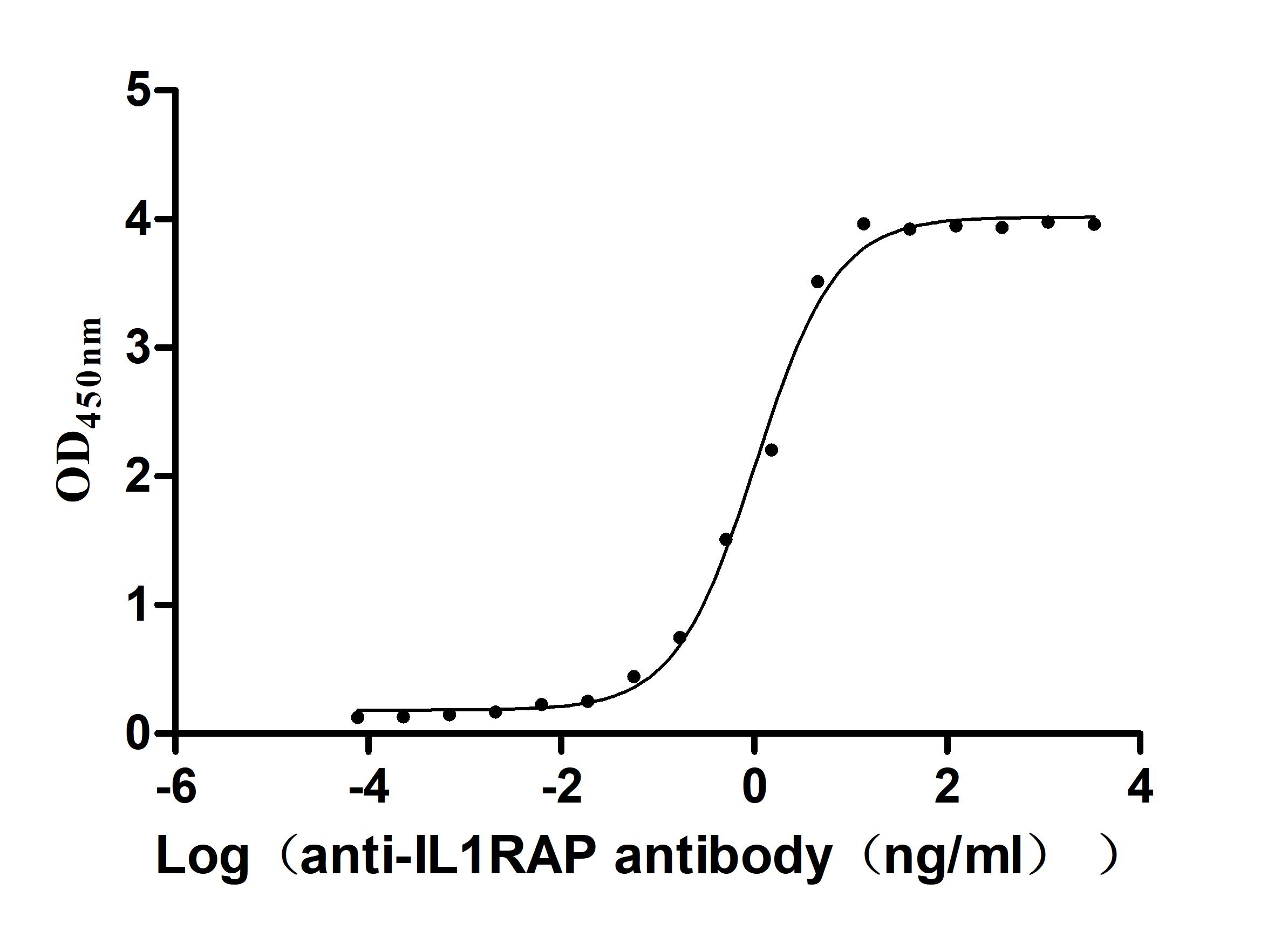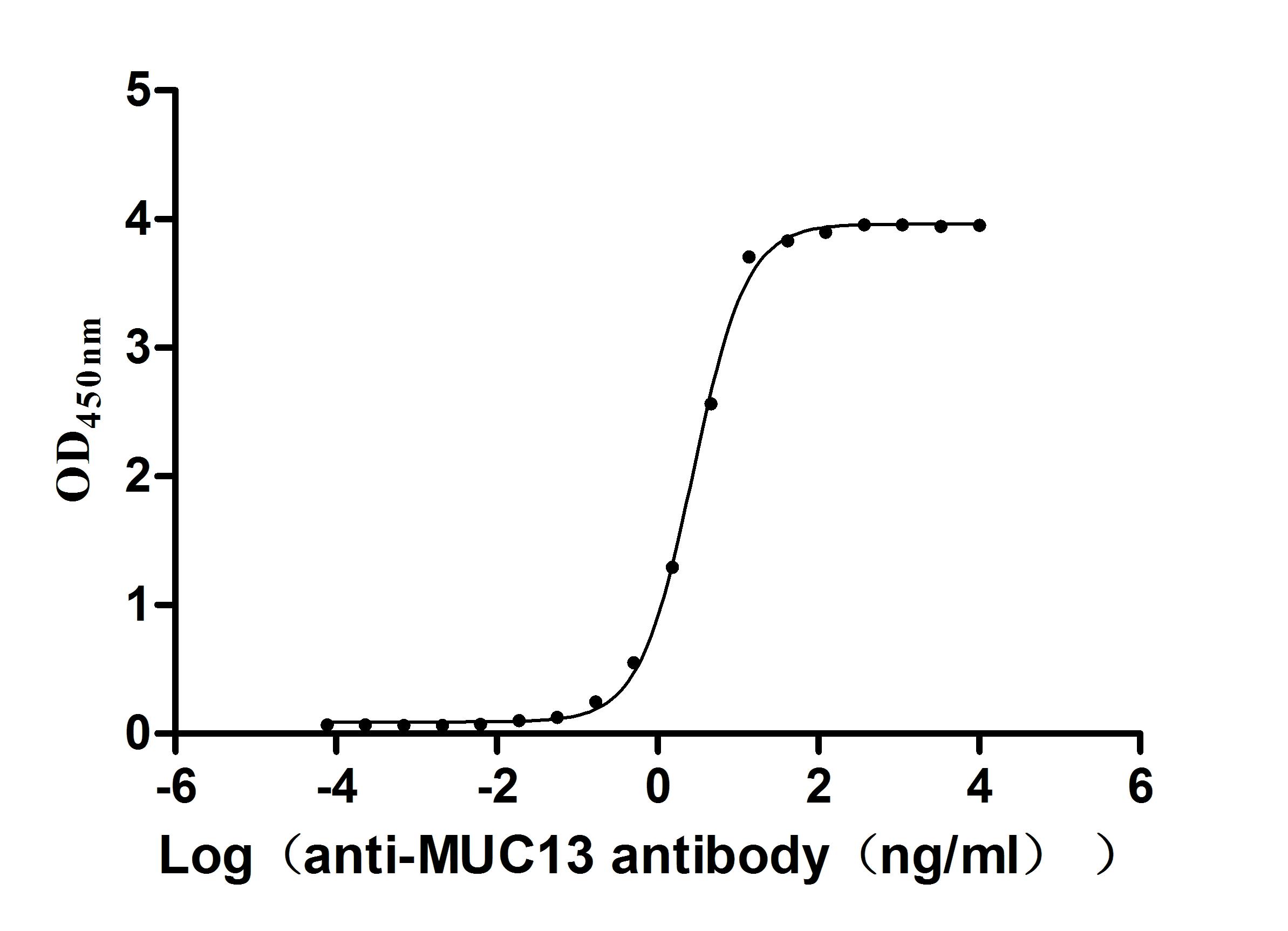Recombinant Human Telomeric repeat-binding factor 2 (TERF2)
-
货号:CSB-YP620883HU
-
规格:
-
来源:Yeast
-
其他:
-
货号:CSB-EP620883HU
-
规格:
-
来源:E.coli
-
其他:
-
货号:CSB-EP620883HU-B
-
规格:
-
来源:E.coli
-
共轭:Avi-tag Biotinylated
E. coli biotin ligase (BirA) is highly specific in covalently attaching biotin to the 15 amino acid AviTag peptide. This recombinant protein was biotinylated in vivo by AviTag-BirA technology, which method is BriA catalyzes amide linkage between the biotin and the specific lysine of the AviTag.
-
其他:
-
货号:CSB-BP620883HU
-
规格:
-
来源:Baculovirus
-
其他:
-
货号:CSB-MP620883HU
-
规格:
-
来源:Mammalian cell
-
其他:
产品详情
-
纯度:>85% (SDS-PAGE)
-
基因名:
-
Uniprot No.:
-
别名:Telomeric DNA binding protein; Telomeric DNA-binding protein; Telomeric repeat binding factor 2; Telomeric repeat binding protein 2; Telomeric repeat-binding factor 2; TERF 2; Terf2; TERF2_HUMAN; TRBF 2; TRBF2; TRF 2; TRF2; TTAGGG repeat binding factor 2; TTAGGG repeat-binding factor 2
-
种属:Homo sapiens (Human)
-
蛋白长度:full length protein
-
表达区域:1-542
-
氨基酸序列MAAGAGTAGPASGPGVVRDPAASQPRKRPGREGGEGARRSDTMAGGGGSSDGSGRAAGRRASRSSGRARRGRHEPGLGGPAERGAGEARLEEAVNRWVLKFYFHEALRAFRGSRYGDFRQIRDIMQALLVRPLGKEHTVSRLLRVMQCLSRIEEGENLDCSFDMEAELTPLESAINVLEMIKTEFTLTEAVVESSRKLVKEAAVIICIKNKEFEKASKILKKHMSKDPTTQKLRNDLLNIIREKNLAHPVIQNFSYETFQQKMLRFLESHLDDAEPYLLTMAKKALKSESAASSTGKEDKQPAPGPVEKPPREPARQLRNPPTTIGMMTLKAAFKTLSGAQDSEAAFAKLDQKDLVLPTQALPASPALKNKRPRKDENESSAPADGEGGSELQPKNKRMTISRLVLEEDSQSTEPSAGLNSSQEAASAPPSKPTVLNQPLPGEKNPKVPKGKWNSSNGVEEKETWVEEDELFQVQAAPDEDSTTNITKKQKWTVEESEWVKAGVQKYGEGNWAAISKNYPFVNRTAVMIKDRWRTMKRLGMN
-
蛋白标签:Tag type will be determined during the manufacturing process.
The tag type will be determined during production process. If you have specified tag type, please tell us and we will develop the specified tag preferentially. -
产品提供形式:Lyophilized powder
Note: We will preferentially ship the format that we have in stock, however, if you have any special requirement for the format, please remark your requirement when placing the order, we will prepare according to your demand. -
复溶:We recommend that this vial be briefly centrifuged prior to opening to bring the contents to the bottom. Please reconstitute protein in deionized sterile water to a concentration of 0.1-1.0 mg/mL.We recommend to add 5-50% of glycerol (final concentration) and aliquot for long-term storage at -20℃/-80℃. Our default final concentration of glycerol is 50%. Customers could use it as reference.
-
储存条件:Store at -20°C/-80°C upon receipt, aliquoting is necessary for mutiple use. Avoid repeated freeze-thaw cycles.
-
保质期:The shelf life is related to many factors, storage state, buffer ingredients, storage temperature and the stability of the protein itself.
Generally, the shelf life of liquid form is 6 months at -20°C/-80°C. The shelf life of lyophilized form is 12 months at -20°C/-80°C. -
货期:Delivery time may differ from different purchasing way or location, please kindly consult your local distributors for specific delivery time.Note: All of our proteins are default shipped with normal blue ice packs, if you request to ship with dry ice, please communicate with us in advance and extra fees will be charged.
-
注意事项:Repeated freezing and thawing is not recommended. Store working aliquots at 4°C for up to one week.
-
Datasheet :Please contact us to get it.
相关产品
靶点详情
-
功能:Binds the telomeric double-stranded 5'-TTAGGG-3' repeat and plays a central role in telomere maintenance and protection against end-to-end fusion of chromosomes. In addition to its telomeric DNA-binding role, required to recruit a number of factors and enzymes required for telomere protection, including the shelterin complex, TERF2IP/RAP1 and DCLRE1B/Apollo. Component of the shelterin complex (telosome) that is involved in the regulation of telomere length and protection. Shelterin associates with arrays of double-stranded 5'-TTAGGG-3' repeats a...显示更多
-
基因功能参考文献:
- ROC curves analysis displayed TERF2 and RTA as two promising markers in disease diagnosis. In addition to that, Univariate analysis of clinico-pathological parameters and studied genes, TERF2 and RTA demonstrated significant association of these molecules in disease progression and are good predictor of disease course thus suggesting their utility in prognosis of MM. PMID: 29043869
- Both GEM and CAP caused telomere shortening and increased expression of TRF2 with improved ascites in nude mice and decreased in vitro clonogenic activity. TRF2 knockdown altered telomeres to a shortened but new status that may evade XPF-dependent telomere loss and conferred resistance of SKOV3.ip1 ascites cells to low-dose GEM and CAP. PMID: 28088627
- We demonstrate that promoter binding by TRF2 mediates PCGF3 promoter activity, and both the N-terminal and C-terminal domains of TRF2 are necessary for promoter activity PMID: 29589913
- The reports the crystal structure of the N-terminal domain of TIN2 in complex with TIN2-binding motifs from TPP1 and TRF2, revealing how TIN2 interacts cooperatively with TPP1 and TRF2. PMID: 29160297
- the excessive HULC plus MALAT1 reduced the methylation of the TERC promoter dependent on TRF2, increasing the TERC expression that causes the increase of interplay between TRET and TERC. PMID: 27782152
- TERF2 knockdown by RNA interference had no effect on cell proliferation, migration, senescence and apoptosis. Instead, TERF2 knockdown increased the expression of cytokines implicated in inflammation and angiogenesis, except for vascular endothelial growth factor. PMID: 27329590
- the telomere stability is under direct control of one of the major pro-oncogenic signaling pathways (RAS/RAF/MEK/ERK) via TRF2 phosphorylation. PMID: 27366950
- the B-domain improves TRF2's interaction with DNA via enhanced long-range electrostatic interactions. PMID: 28981702
- our findings describe TRF2 as a novel SIRT6 substrate and demonstrate that acetylation of TRF2 plays a crucial role in the regulation of TRF2 protein stability, thus providing a new route for modulating its expression level during oncogenesis and damage response. PMID: 27923994
- The results suggest that dimerized TRF2 recruits origin recognition complex and stimulates pre-replication complex formation at telomeres through the TRFH domain. PMID: 27836746
- Studied the disruption pattern of of 3D telomere-TRF2 interaction in the progression from mononuclear Hodgkin cells (H) to multinucleated Reed-Sternberg cells (RS). PMID: 28436953
- TRF2, a component of shelterin, binds to core histones to protect chromosome ends from inappropriate DNA damage response and loss of telomeric DNA. The N-terminal Gly/Arg-rich domain (GAR domain) of TRF2 directly binds to the globular domain of core histones. PMID: 27514743
- TRF2 deficiency led to a 1,5-2 fold increase in the radiosensitivity of hMSC-telo1 cells through telomere destabilization. PMID: 26598048
- DREEM imaging shows that in contrast to chromatin with DNA wrapping around histones, large TRF2-DNA complexes (with volumes larger than TRF2 tetramers) compact DNA inside TRF2 with portions of folded DNA appearing at the edge of these complexes. PMID: 26856421
- observed that the expression of Sp1 is down-regulated in the TRF2(DeltaBDeltaM)-induced senescence, which was mediated by ATM and p38 MAPK PMID: 26906205
- Data show that isoform beta2 of the heregulin (HRGbeta2) localizes at telomeres with the telomere-associated proteins TRF2 and RAP1. PMID: 26318724
- These observations suggest that TRF2 is a good candidate for the attachment of telomeres to the nuclear envelope in somatic cells PMID: 26572976
- Through a combination of biochemical, biophysical and structural approaches, we unveiled a unique mode of assembly between RAP1 and TRF2 PMID: 26748096
- that a dimer of the shelterin subunit TRF2 wraps approximately 90 bp of DNA through several lysine and arginine residues localized around its homodimerization domain. PMID: 26774283
- TRF2 overexpression results in replication stalling in duplex telomeric repeat tracts and formation of telomeric ultrafine anaphase bridges, ultimately leading to stochastic loss of telomeric sequences. PMID: 26640040
- APB formation induced clustering of telomere repeats, telomere compaction and concomitant depletion of the shelterin protein TRF2 (also known as TERF2). PMID: 25908860
- Study demonstrates that TRF2 interacts with and is sumoylated by PIAS1 and RNF4 targets SUMO-conjugated TRF2 for ubiquitination, thereby decreasing its stability suggesting that TRF2 status provides a molecular switch that controls its level at telomeres. PMID: 26450775
- TRF2 is a specific target of miR-23a, and uncover a previously unknown role for miR-23a in telomere regulation and cellular senescence PMID: 25753893
- The variability of genes encoding for TERF1 and TNKS2 is important for keeping the integrity of the telomere structure and show a significant association with longevity. PMID: 25631672
- represses TERRA transcription through its homodimerization domain PMID: 25359189
- interaction between with lamin A/C on chromosome structure and cellular and organismal aging PMID: 25399868
- data suggest that TRF2 is a radioresistant protein in A549 and U2OS cells. PMID: 25609072
- TRF2-mediated counterbalance between hREST4 and REST is vital for both the generation and maintenance of neural progenitor cells PMID: 24740933
- TRF2 binds and transactivates the promoter of the angiogenic tyrosine kinase platelet-derived growth factor receptor beta (PDGFRbeta). PMID: 25437559
- Data show that full-length repressor activator protein 1 (Rap1) binds to full-length telomeric repeat binding factor 2 (TRF2) with high affinity and equimolar ratio. PMID: 25675958
- TRF2 is involved in the recruitment of RTEL1 to facilitate t-loop disassembly at telomeres in S phase. PMID: 25620558
- these results suggest that the altered nuclear staining of methylated TRF2 may represent nuclear structural alteration associated with cellular senescence. PMID: 24721747
- KIP binding to TRF2 enhances the telomere-binding activity of TRF2, suggesting that KIP acts as a positive regulator of TRF2 function. PMID: 25012820
- Findings lead s to propose a model in which telomeres are directly protected from c-NHEJ via TRF2 impeding Ku's ability to synapse telomere ends. PMID: 24095731
- Aging in hESC-derived CMs correlated with reduced membrane potential in mitochondria, the accumulation of lipofuscin, a slower beating pattern, and the downregulation of human telomerase RNA (hTR) and cell cycle regulating genes. PMID: 22843416
- The wnt/beta-catenin signalling pathway maintains a level of TRF2 critical for telomere protection. PMID: 23429341
- High level of TRF2 in tumour cells decreased their ability to recruit and activate natural killer cells and contribute to oncogenesis. PMID: 23792691
- The TRF2, is recruited to sites of DNA damage and plays critical roles in the DNA damage response. PMID: 22841872
- Doxorubicin induces uPAR-mediated proteasomal activity & ubiquitination of TRF2 in VSMC from umbilical artery. uPAR also controls nuclear accumulation and DNA binding of TRF2. PMID: 23172421
- Low TRF2 expression is associated with chronic lymphocytic leukemia. PMID: 22878603
- results indicate that REST-dependent TRF2 expression renders cancer cells resistant to DNA damage during oxidative stress PMID: 22821339
- as hTRF2 recruits hRap1 to telomeric sequences, hRap1 alters the affinity of hTRF2 and its binding preference on telomeric DNA. Moreover, the TRF2-Rap1 complex has higher ability to re-model telomeric DNA PMID: 23086976
- Gemcitabine causes telomere shortening by stabilizing TRF2 that is required for XPF-dependent telomere loss. Overexpression of TRF2 in the absence of gemcitabine also causes telomere shortening with simultaneous association of TRF2 with XPF/ERCC1. PMID: 22704123
- The TRF2 stimulates the binding and enzymatic activities of the LP-BER proteins APE1, FEN1 and LigI both individually and when they act together in reconstituted LP-BER using a telomeric substrate. PMID: 22336916
- The telomeric protein TRF2 binds Telomeric repeat-containing RNA (TERRA) via interactions that necessitate the formation of a G-quadruplex structure rather than the TERRA sequence per se. PMID: 22780456
- TRF2 negatively regulates the number of nucleosomes at human telomeres by a cell cycle-dependent mechanism that alters internucleosomal distance. PMID: 22536324
- increased TRF2 immunostaining intensity in invasive carcinomas is associated with shorter telomeres and shorter telomeres correlate with a higher TNM stage PMID: 20625812
- Data show that mutant template human telomerase RNAs (MT-hTers) induce DNA damage after phosphorylation of ATM and p53 via suppression of TRF2, which may eventually lead to apoptosis via elevation of GADD45gamma. PMID: 21824286
- Study investigated the binding sites of telomeric proteins along human chromosomes; RAP1 and TRF2 could be found on a small number of interstitial sites, including regions that are proximal to genes. PMID: 21423278
- Silencing TRF2 can inhibit proliferation of Hep-2 cells. PMID: 21395184
收起更多
-
亚细胞定位:Nucleus. Chromosome, telomere. Note=Colocalizes with telomeric DNA in interphase cells and is located at chromosome ends during metaphase.
-
组织特异性:Ubiquitous. Highly expressed in spleen, thymus, prostate, uterus, testis, small intestine, colon and peripheral blood leukocytes.
-
数据库链接:
HGNC: 11729
OMIM: 602027
KEGG: hsa:7014
STRING: 9606.ENSP00000254942
UniGene: Hs.63335



















